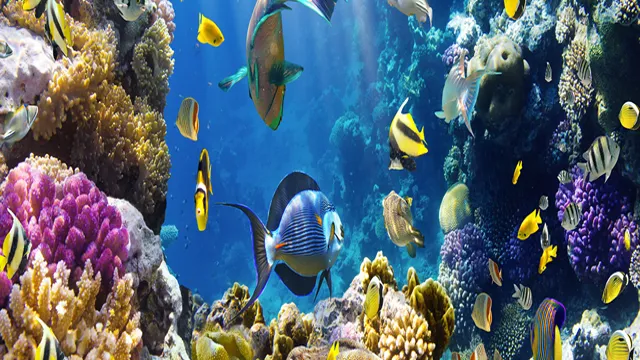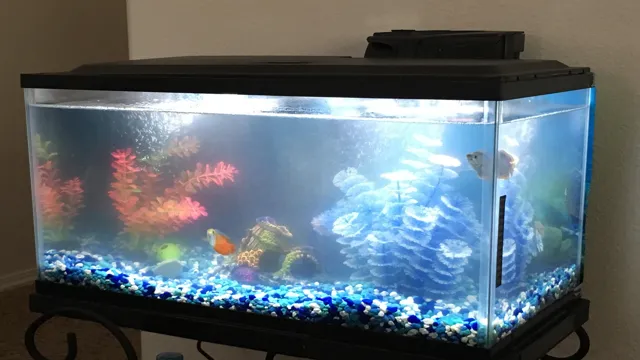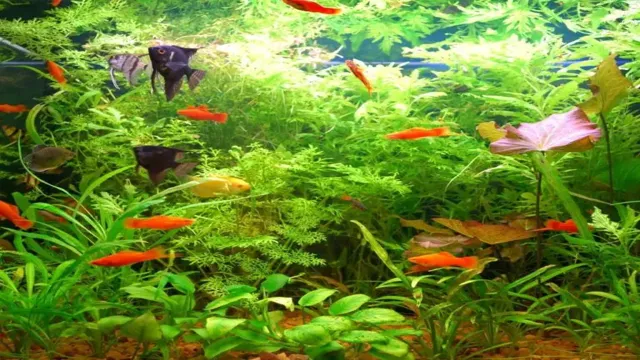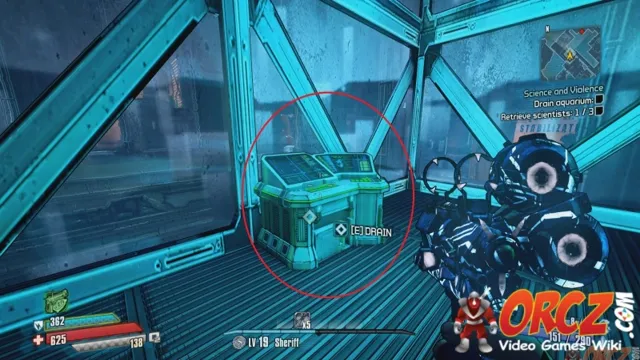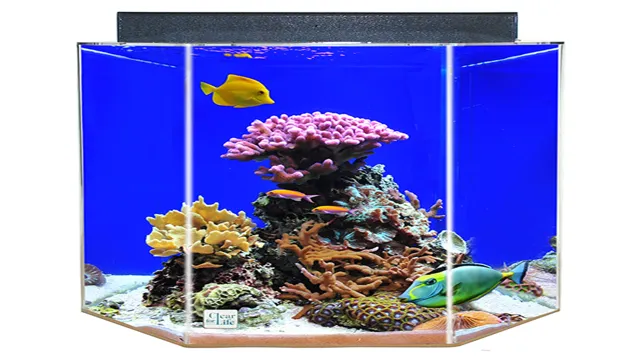How to Decrease Nitrate in Saltwater Aquarium: Ultimate Guide for Aquarium Owners
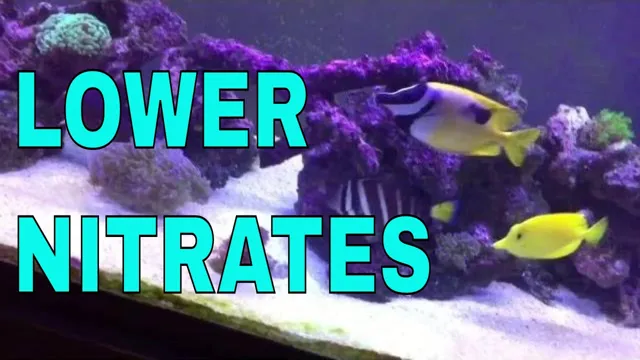
Are you struggling with high nitrate levels in your saltwater aquarium? If so, you’re not alone. Nitrate can be a tricky problem to tackle, but it’s important for the health of your aquatic inhabitants to keep those levels in check. High nitrate concentrations can lead to algae blooms and even harm your fish and invertebrates.
That’s why it’s crucial to understand why nitrate builds up and how to decrease it in your tank. In this blog post, we’ll dive into the causes of nitrate buildup and provide practical tips for managing it in your saltwater aquarium. So, let’s get started!
Understanding Nitrate
If you’re a novice to saltwater aquariums, you may be wondering what nitrate is and how to decrease it. Nitrate is a common byproduct of the nitrogen cycle in an aquarium and is essentially the waste produced by your fish and bacteria. High nitrate levels can lead to algae growth, excess nutrients, and harm to your fish’s health.
Fortunately, there are several ways to decrease nitrate in your aquarium, such as performing regular water changes, adding live plants or algae, and using nitrate-reducing additives. It’s crucial to monitor your aquarium’s nitrate levels regularly to maintain a healthy and thriving aquarium environment. So, ensure that you’re cleaning your aquarium often and closely monitoring nitrate levels to keep everything in balance.
Remember that proper aquarium maintenance is key to the success of your aquarium in the long run, and keeping nitrate levels low is just one aspect of a healthy and thriving saltwater aquarium.
What is Nitrate?
Nitrate is an essential compound found in soil and water that is vital for many plant and animal species to survive. As a form of nitrogen, nitrate is important for the growth and development of plants, as it helps them produce proteins and chlorophyll. However, excessive nitrate levels can lead to environmental problems, including water pollution and the creation of harmful algal blooms.
Nitrate can also have detrimental effects on human beings, particularly infants and pregnant women, as high intake levels can lead to a condition called methemoglobinemia or “blue baby syndrome.” Understanding the role and impact of nitrate is crucial for maintaining a healthy environment and promoting well-being for all living things.

Why is Nitrate Harmful?
Nitrate is a compound that naturally occurs in our environment. It is found in soil, water, and even in the air we breathe. While it is necessary for plant growth, high levels of nitrate can be harmful.
When nitrate levels in water surpass safe thresholds, it can be dangerous to human health, particularly to infants and pregnant women. Nitrate can interfere with the ability of the blood to carry oxygen, causing a condition called methemoglobinemia or “blue baby” syndrome- a severe oxygen deficiency in babies. However, nitrate is not only toxic to humans but also can have adverse effects on aquatic organisms and the environment.
When nitrate-rich water enters waterways and oceans, it can lead to algal blooms and the death of many marine organisms. As a result, regulating and managing nitrate levels is critical in ensuring the health and well-being of both humans and the environment.
Causes of High Nitrate Levels
Are you noticing high nitrate levels in your saltwater aquarium and wondering how to decrease them? Some of the common causes of high nitrate levels in the aquarium include overfeeding, inadequate filtration, and lack of water changes. Overfeeding leads to excess nutrients, which eventually build up and result in high nitrate levels. Inadequate filtration and lack of water changes prevent the removal of waste and other organic matter, leading to the build-up of nitrates.
To decrease nitrate levels, you can start by reducing the amount of food given to your fish and feeding them only what they can consume within a few minutes. You can also upgrade your filtration system and incorporate live plants and algae to help absorb nitrates from the water. Water changes are also important in maintaining a healthy aquarium environment, so make sure to perform them regularly.
By taking these measures, you can reduce nitrate levels and create a healthier environment for your aquatic pets. (See Also: How to Determine Bioload in Aquarium: A Comprehensive Guide for Fish Keepers.)
Overfeeding
Overfeeding is one of the most common causes of high nitrate levels in aquariums. When fish are fed too much, they produce more waste than can be broken down by the biological filtration system. This excess waste leads to an increase in nitrate levels, which can be harmful to fish and other aquatic creatures.
Overfeeding can also lead to other problems, such as algae growth and a decrease in oxygen levels. To avoid this issue, it’s important to feed fish the right amount of food, taking into account their size, species, and appetite. A good rule of thumb is to feed fish small amounts of food two to three times a day, rather than one large meal.
This will help ensure that the filtration system can keep up with the waste produced by the fish. Remember, overfeeding can be harmful to your aquarium inhabitants, so it’s important to be mindful of how much you’re feeding them.
Overstocking
Overstocking is a major cause of high nitrate levels in aquariums. When too many fish and other animals are kept in a tank, their waste output surpasses the ability of the filtration and other cleaning systems to maintain a healthy environment. This excess waste forms ammonia, which then converts into nitrate – a compound that is toxic to fish at high levels.
Not only can overstocking be lethal to fish, but it can also lead to other issues like algae overgrowth, which further drains the oxygen supply in the water. If left unchecked, high nitrate levels can lead to significant water quality issues and even the death of fish and other aquatic animals. To prevent this, always research and adhere to recommended stocking levels for your particular tank size and species of fish.
Poor Filtration
Poor Filtration High nitrate levels in aquariums can lead to poor water quality and negatively impact the health of your fish. One of the main causes of high nitrate levels is poor filtration. Inadequate filtration can result in organic waste, uneaten food, and fish waste to accumulate in the tank.
As these substances break down, they produce ammonia, which is then converted into nitrite and then nitrate, leading to high nitrate levels. To prevent this from happening, it is important to ensure that your aquarium has adequate filtration, which should include mechanical filtration to remove debris and biological filtration to convert harmful substances into less harmful forms. Additionally, regular water changes can help to lower nitrate levels and maintain a healthy environment for your fish.
Remember, poor filtration can not only lead to high nitrate levels but also ammonia and nitrite toxicity, which can be fatal to fish, so it is crucial to keep your aquarium clean and well-filtered.
Overskimming
Overskimming is one of the primary causes of high nitrate levels in bodies of water. This process occurs when excess nutrients, such as nitrogen and phosphorus, are introduced to the water, encouraging algae growth. When this algae dies, it begins to decompose, using up dissolved oxygen in the water, which can lead to the death of fish and other aquatic life.
Overskimming can occur as a result of human activities such as agriculture, industrial pollution, and sewage discharges. Farmers, for example, may use too much fertilizer on their crops or improperly manage their manure, causing excess nutrients to leach into the water. Similarly, industries may discharge untreated waste or improperly dispose of chemicals, which can lead to increased nitrate levels.
Proper management of these activities and the implementation of regulations can help prevent overskimming and protect our waterways from the harmful effects of high nitrate levels. (See Also: How to Make Your Aquarium Water Never Need to Change: Simple Tips)
Methods to Reduce Nitrate Levels
If you’re struggling with high nitrate levels in your saltwater aquarium, don’t worry – there are plenty of methods you can use to decrease them. One effective solution is to perform regular water changes, which can remove excess nitrates and other contaminants from the water. Another option is to add plants or algae to your tank, as these organisms can absorb nitrates as part of their natural growth processes.
You can also try using a protein skimmer, which can help remove organic waste from the water before it breaks down into nitrates. Finally, consider feeding your fish and other animals less frequently or in smaller amounts, as excess food can contribute to nitrate buildup over time. By incorporating these methods into your regular aquarium maintenance routine, you can help keep your nitrate levels under control and promote a healthier ecosystem for your aquatic pets.
Decrease Feeding
Reducing nitrate levels in aquariums is crucial to maintaining a healthy environment for your aquatic pets. One effective method for reducing nitrate levels is decreasing feeding. Overfeeding fish can lead to excess waste, which breaks down into nitrates.
This can cause an alarming rise in nitrate levels in your aquarium. By feeding your fish less, you can reduce the amount of waste that accumulates and, in turn, lower nitrate levels. However, keep in mind that while reducing feeding can help decrease nitrate levels, it is important to ensure that your fish are still getting the necessary nutrients they need to stay healthy.
A balanced feeding schedule is essential for maintaining a healthy aquarium environment. By monitoring your fish’s eating habits and adjusting their diet accordingly, you can effectively reduce nitrate levels while keeping your aquatic pets happy and healthy.
Increase Water Changes
If you’re struggling to reduce nitrate levels in your aquarium, one method that is highly effective is increasing water changes. Nitrate buildup in the water is a common issue in aquariums that can lead to fish sickness and even death. Regular water changes can help dilute the concentration of nitrates in the water, making it a safer environment for your fish.
Depending on the size of your tank and the number of fish you have, you may need to do water changes every week or every other week. Be sure to remove any uneaten food and waste from the substrate before doing the water change, and use a water conditioner to neutralize any chlorine or other chemicals in your tap water. By consistently performing regular water changes, you can help keep your aquarium healthy and your fish happy.
Add Nitrate-Reducing Bacteria
Nitrate-reducing bacteria are a fantastic way to combat high nitrate levels in your aquarium or pond. These microorganisms help remove nitrates by converting them into nitrogen gas, which can then safely dissipate into the atmosphere. Adding these bacteria can be done in a few different ways.
You can purchase live bacteria cultures in liquid or powder form and add them directly to your filtration system or water. Alternatively, you can use products that contain dormant bacteria spores that become active once added to water. It’s important to note that adding nitrate-reducing bacteria doesn’t solve the root cause of high nitrate levels, so it’s also essential to maintain proper cleaning and maintenance practices to keep nitrate levels under control.
Overall, adding nitrate-reducing bacteria is an effective and natural way to keep your aquarium or pond healthy and free of harmful nitrates.
Use Macroalgae and Plants
One effective method to reduce excess nitrate levels in your aquatic environment is to use macroalgae and plants. These organisms naturally absorb nutrients such as nitrates and phosphates through their leaves and stems, helping to maintain a healthy balance in your water system. Macroalgae such as Chaetomorpha and Caulerpa are particularly efficient at removing excess nitrates, as they have a high surface area and can grow rapidly in the right conditions.
In addition, submerged plants such as Anubias and Java Fern also offer benefits by absorbing nutrients through their roots. By incorporating these natural filtration methods into your aquarium or pond, you can reduce the need for chemical treatments and create a more balanced and sustainable ecosystem. So why not give your aquatic pets and plants the best water quality possible by harnessing the power of macroalgae and plants? (See Also: How to Grow Coral in Aquarium: A Comprehensive Guide for Novice Aquarists)
Conclusion
In conclusion, decreasing nitrate in your saltwater aquarium requires a combination of proper maintenance, consideration of your feeding habits, and strategic placement of live rocks and plants. Remember that nitrate is an inevitable byproduct of a thriving aquarium ecosystem, but with a little effort, you can keep it at bay and maintain a healthy and vibrant underwater world. So make like a fish and dive into these tips to keep your nitrate levels low and your aquarium happy and healthy!”
FAQs
What causes high nitrate levels in a saltwater aquarium?
High nitrate levels in a saltwater aquarium can be caused by several factors such as overfeeding, overstocking, lack of proper filtration, and infrequent water changes.
What are the consequences of high nitrate levels in a saltwater aquarium?
High nitrate levels in a saltwater aquarium can lead to several problems such as poor water quality, algae blooms, fish stress and illness, and coral bleaching.
How frequently should I perform water changes to reduce nitrate levels in my saltwater aquarium?
It is recommended to perform regular water changes of 10-20% every 2-4 weeks to maintain healthy nitrate levels in a saltwater aquarium.
What are some natural ways to decrease nitrate levels in a saltwater aquarium?
Some natural ways to decrease nitrate levels in a saltwater aquarium include introducing live plants, using natural filtration methods such as a protein skimmer or refugium, and reducing the feeding and stocking levels.
Can I use chemical nitrate removers in my saltwater aquarium?
Yes, there are several chemical nitrate removers available in the market such as nitrate sponge, nitrate reactor, and nitrate removal media that can be used to reduce nitrate levels in a saltwater aquarium. However, it is important to follow the instructions and dosage carefully to avoid any adverse effects.
How can I prevent nitrate buildup in my saltwater aquarium?
To prevent nitrate buildup in a saltwater aquarium, it is important to maintain a regular cleaning and maintenance schedule, avoid overfeeding and overstocking, use a high-quality protein skimmer, and perform regular water changes.
What should I do if my nitrate levels are still high despite following all the recommended measures?
If the nitrate levels in a saltwater aquarium are still high despite following all the recommended measures, it may be necessary to perform larger water changes, upgrade the filtration system, or reduce the feeding and stocking levels further. It is also advisable to seek advice from a professional aquarist if the problem persists.

